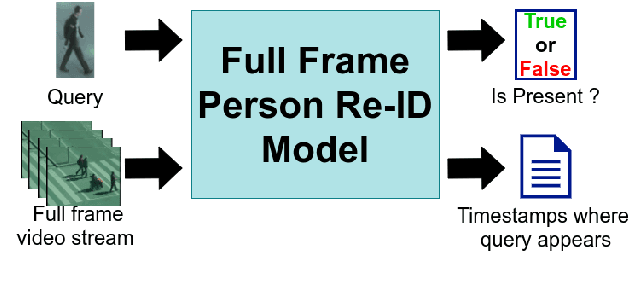Felix O. Sumari
Benchmarking person re-identification datasets and approaches for practical real-world implementations
Dec 20, 2022



Abstract:Recently, Person Re-Identification (Re-ID) has received a lot of attention. Large datasets containing labeled images of various individuals have been released, allowing researchers to develop and test many successful approaches. However, when such Re-ID models are deployed in new cities or environments, the task of searching for people within a network of security cameras is likely to face an important domain shift, thus resulting in decreased performance. Indeed, while most public datasets were collected in a limited geographic area, images from a new city present different features (e.g., people's ethnicity and clothing style, weather, architecture, etc.). In addition, the whole frames of the video streams must be converted into cropped images of people using pedestrian detection models, which behave differently from the human annotators who created the dataset used for training. To better understand the extent of this issue, this paper introduces a complete methodology to evaluate Re-ID approaches and training datasets with respect to their suitability for unsupervised deployment for live operations. This method is used to benchmark four Re-ID approaches on three datasets, providing insight and guidelines that can help to design better Re-ID pipelines in the future.
Towards Practical Implementations of Person Re-Identification from Full Video Frames
Sep 02, 2020



Abstract:With the major adoption of automation for cities security, person re-identification (Re-ID) has been extensively studied recently. In this paper, we argue that the current way of studying person re-identification, i.e. by trying to re-identify a person within already detected and pre-cropped images of people, is not sufficient to implement practical security applications, where the inputs to the system are the full frames of the video streams. To support this claim, we introduce the Full Frame Person Re-ID setting (FF-PRID) and define specific metrics to evaluate FF-PRID implementations. To improve robustness, we also formalize the hybrid human-machine collaboration framework, which is inherent to any Re-ID security applications. To demonstrate the importance of considering the FF-PRID setting, we build an experiment showing that combining a good people detection network with a good Re-ID model does not necessarily produce good results for the final application. This underlines a failure of the current formulation in assessing the quality of a Re-ID model and justifies the use of different metrics. We hope that this work will motivate the research community to consider the full problem in order to develop algorithms that are better suited to real-world scenarios.
 Add to Chrome
Add to Chrome Add to Firefox
Add to Firefox Add to Edge
Add to Edge